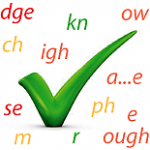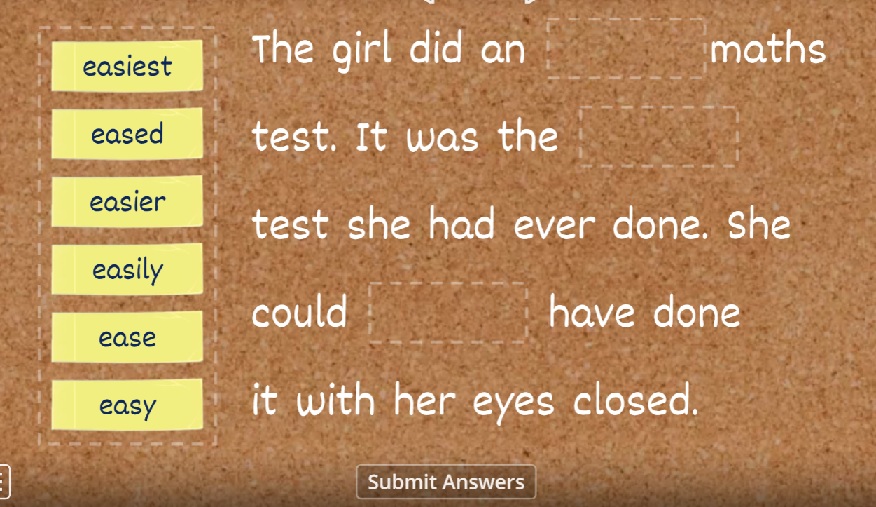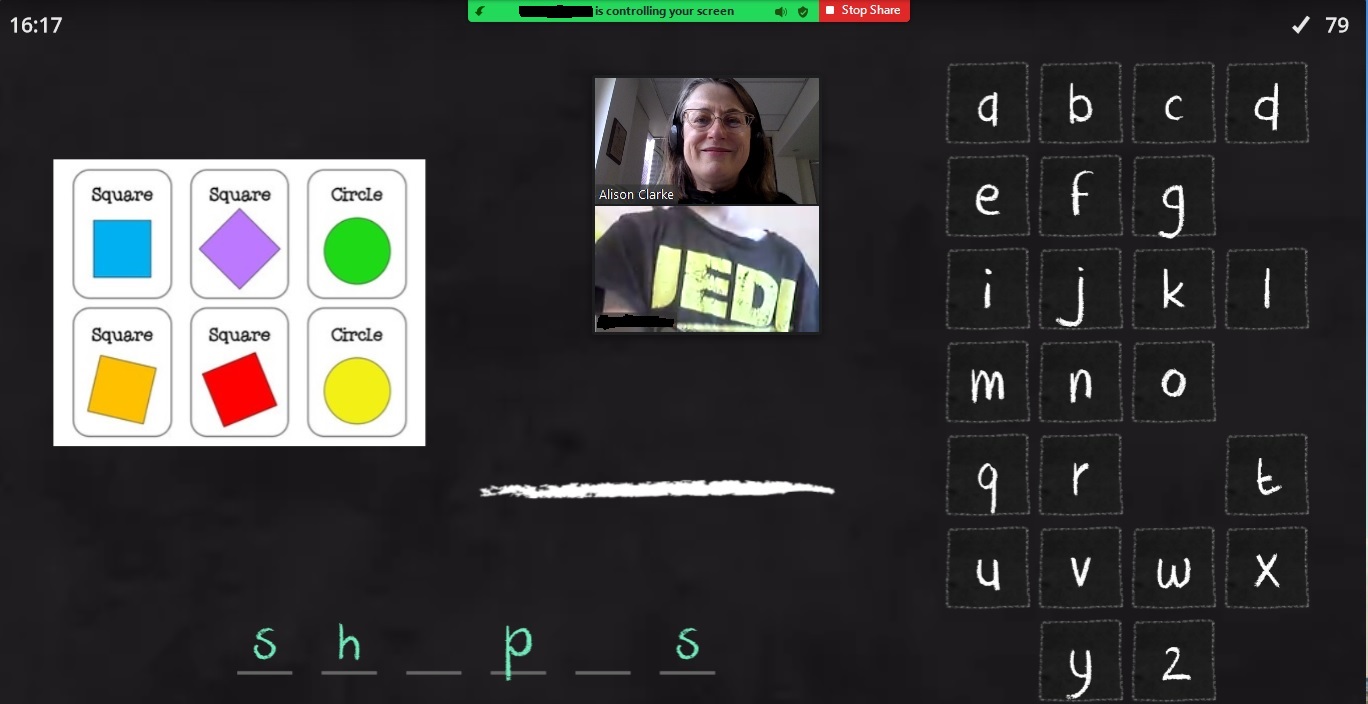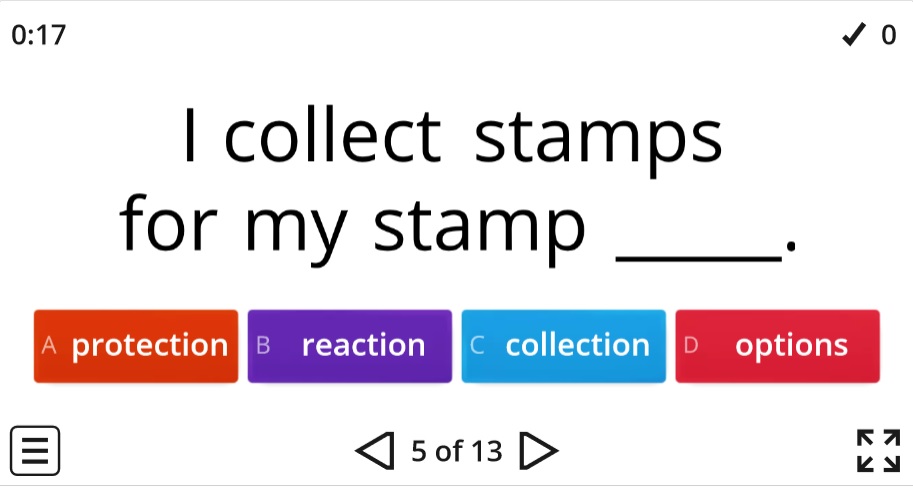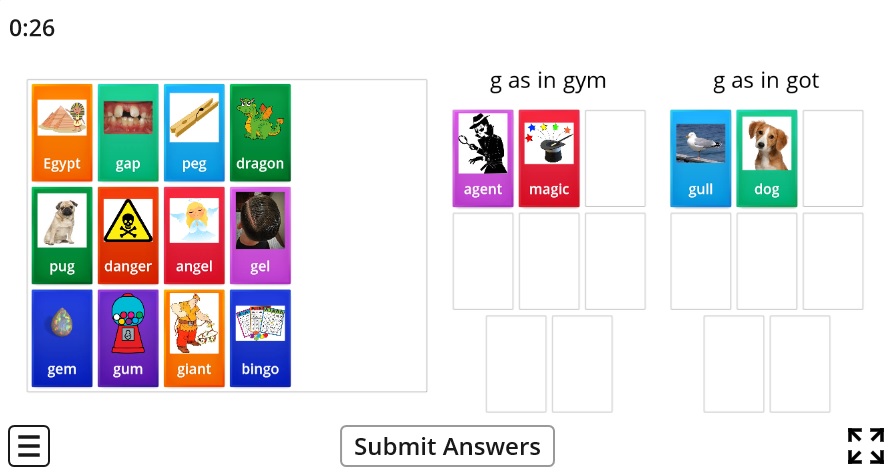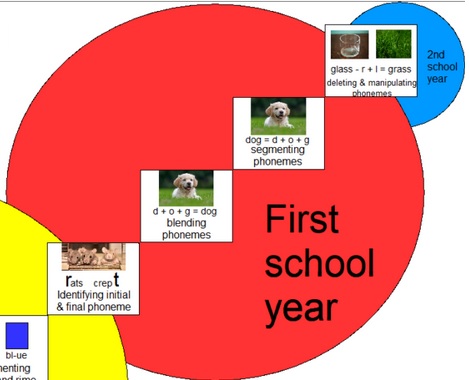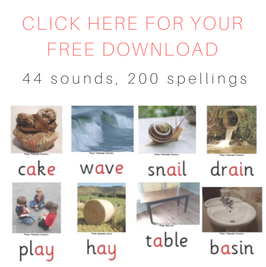New printable decodables and free quizzes
11 RepliesI’ve just made free follow-up Wordwall quizzes for all the Phonics With Feeling decodable readers, including three new Extended Code Set 1 books now available (update January 2022: There are now 5 books in this set).
The 41 quizzes, of ~20 questions each, are all in a folder called Phonics With Feeling here. I’ve also made printable versions without pictures, which you can download for free here.
The online quizzes are made in the basic Wordwall Quiz format, but you can use them in Gameshow Quiz format for a few more bells and whistles, which many children enjoy, though the timer freaks some highly anxious children out. Click at the right of the startup screen if you want to switch to Gameshow format:
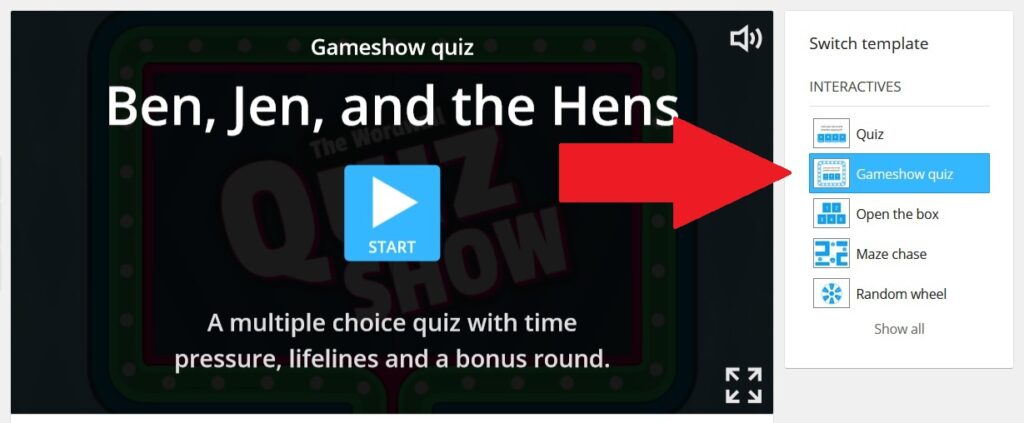
Click on the Share button below each quiz to set it as an after-reading assignment.
The quiz questions are comprehension/concept questions about the Phonics With Feeling readers, which provide extra Really-Nail-That-Pattern practice for children in Years 1 or 2, or slightly older struggling learners. The Initial Code readers are also suitable for many children approaching the end of their first school year (we Victorians call them Preps). Each quiz is written at the same decoding level as the relevant reader.
The quizzes contain some deliberate garden path questions, and traps for picture-guessers and kids inclined to read the start and end of words, and guess the middles, e.g. “Did Red Hen make a net?” followed by “Did Red Hen make a nest?” I hope this makes skimming kids do a double-take, and look more closely at ALL the letters.
The three new Extended Code Set One Phonics With Feeling readers look like this once you’ve printed them with nice coloured cardboard covers:
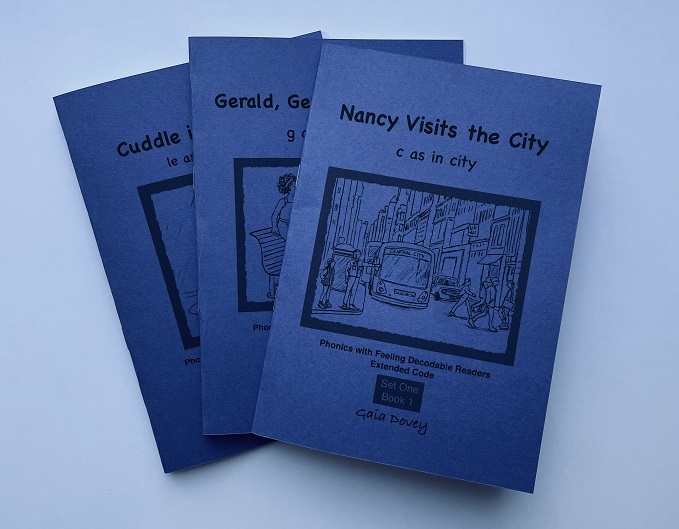
These new books target:
- /s/ as in ‘cent’ (spelt C),
- /j/ as in ‘gem’ (spelt G) and
- Unstressed final syllable ‘le’ as in ‘candle’ and ‘middle’.
Like all the other Phonics With Feeling books, the Parent/Aide version allows you to print up to 5 copies of each book for 40c per copy, plus printing and materials costs.
If you want to use the books with a whole class or caseload, the Teacher/Clinician versions allow printing of up to 30 copies of each book, which works out at 20c per print. We hope this allows teachers to use them as class sets, and have a few spares to replace any that get lost, leaked on by drink bottles, chewed by puppies etc.
The download-and-print quizzes don’t have pictures, and may be useful as follow-up paper-based activities, or you might like to turn the questions into Kahoot!s, or other games/competitions. If my quizzes are too long for your students, just leave some of the questions out, and tweak the remainder. Save yourself the brain-frying experience of writing decodable text from scratch.
40 Phonics with Feeling books are currently available, but I’ve made 41 Wordwall quizzes, because the last Set Seven book has two stories in it – ‘Sue and the Glue’ and ‘Robot Andrew’. The Phonics With Feeling Extended Code Set Three should be available in November, and will target single-letter ‘short/long’ vowels, providing children with many opportunities to practise ‘flipping’ vowel sounds till they get a word they know that makes sense in context (e.g. the ‘o’ in ‘poster’ and ‘roster’).
Still too hard for your learners? Try the new, free Sounds-Write texts
If these books and quizzes are too hard for your kids, and you need more basic decodable texts, Sounds-Write has a cute new free e-book First Steps Collection about strange pets (including a bug, a fox, a crab, a skunk, a moth, a chimp and a squid), for Units 4-11 of Sounds-Write. They’re a bit easier than the original Sounds Write books. Printed versions are also available, though I think at the time of writing they haven’t yet arrived at Australian suppliers DSF, Soundality or Rise Literacy.
If even those books are too difficult for your learner, we’ve made some 10-question WordWall quizzes for Sounds-Write Units 1-3:
- Unit 1 (I realised two of my local MPs are called Tim and Sam, so it’s nonfiction quiz)
- Unit 2 (the featured Pam is Prof Pamela Snow, again very much nonfiction)
- Unit 3.
We’re working on quizzes for later units now, if you can smell our brains frying.
Hope you find at least some of this useful, especially those of you who are still (like us, sigh) in COVID-19 lockdown. Stay well!
A phoneme is like a dog
11 RepliesSome of my best-received blog posts have included analogies to (try to) explain complex ideas. So let’s try another one. A phoneme is like a dog.
We start developing a concept of what a dog is when we first encounter dogs, and hear people call them ‘dog’ (or ‘doggie’, for nice, safe-to-pat ones). One-year-olds then often start calling all four-legged mammals ‘doggie’ (and all large birds ‘duck’).
Over time, we gather data about the main, consistent, observable features of dogs: four legs, two ears, up-turned tail, fur, non-retractable claws, carnivorous, able to bark, yelp and growl. We do this by paying lots of attention to dogs, which isn’t hard when you’re small, and so many dogs are keen to rush over and lick your face.
Size is not a distinctive feature – a chihuahua and an Irish Wolfhound are both dogs. Fur colour and length don’t help, think Afghan hounds and dachshunds. Most dogs like chasing balls and sticks, and being taken for walks, but in my experience, rescue greyhounds say ‘meh’ to walks, and Pomeranians think it’s my job to fetch. Most dogs are friendly, but I’m not in a rush to pat Rottweilers or Bull Terriers.
The Official Thing that makes a dog a dog (even a three-legged one, or a yodelling Basenji), is the Canis lupus familiaris genome, but we usually learn about that well after we’ve pruned, shaped and fleshed out a robust abstract concept of a dog. Meanwhile, out in the real world, every dog is still different.
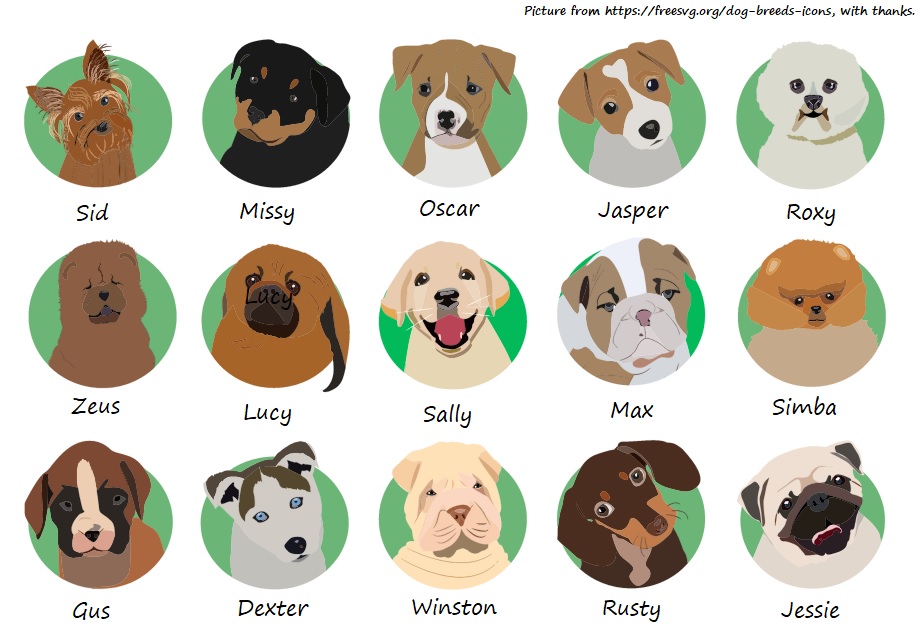
Similarly, literate English-speakers all have a concept of the phoneme /s/, though out in the real, live speech stream, where sounds shmoosh together, every /s/ is different. For the jargon buffs, a phoneme is the idea in your head, and the different ways it shows up in real, actual spoken words are called allophones.
The concept of the phoneme /s/ develops at the intersection of speech and print, when kids notice that a particular kind of sound and mouth gesture in spoken words is represented by the letter ‘s’ in written words.
Speech sounds and mouth gestures are a lot harder to pay attention to than dogs. They don’t rush up and lick you in the face. Speech is invisible and transient, and its gestures are mostly automatised and occurring without conscious effort by school entry, though some kids are still fine-tuning the difference between ‘rock/wok’, ‘freezer/freesia’, ‘thin/fin’ and ‘than/van’, and of course many EAL and Team Speech Therapy kids have more difficulties.
Getting children to say words slowly, listen to the sounds, and feel what’s happening in their mouths while writing/reading the relevant spellings is the teaching equivalent of bringing speech sounds up close enough to lick them in the face. It makes them hard to miss.
While gathering their data about /s/, children might notice that in the word ‘see’ it is produced with retracted lips, while the /s/ in ‘soon’ is produced with rounded lips. However, lip position is not a distinctive feature of the phoneme /s/, in the same way that size and colour don’t really help us work out whether an animal is a calf, cat or dog.
You can prolong /s/ as much as you like in dramatic poems about sly slithering snakes. Length in time is not a distinctive feature in Modern English phonology, though it is in some languages, and Old English had short and long vowels, which is why those terms still hang around today.
Since /s/ is produced slightly differently depending on its word position and neighbours, discerning it needs to be taught in different word positions and with different neighbours. That means saying, reading and writing it in a range of phonetic contexts, in words like ‘sat’, ‘sit’, ‘sob’, ‘sum’, ‘gas’, ‘yes’, ‘bus’, ‘best’, ‘desk’, ‘wisp’, ‘cups’, ‘hats’, ‘banks’, ‘spin’, ‘stem’, ‘skin’, ‘swim’, ‘slip’, ‘snip’, and ‘smog’, not just words starting with the sound /s/, or worse, the letter ‘s’ (sometimes including words like ‘sugar’ and ‘shop’, which don’t even contain the sound /s/, see here, here and here). Teaching about /s/ only in initial position is a bit like teaching about dogs but giving labradors as the only example.
Few adults can give the official, Canis-lupis-familiaris-genome type definition of /s/: it’s a voiceless alveolar fricative. But we know what a /s/ sounds and feels like, and notice when it’s moved so far forward it’s become /th/, or so far back it’s become /sh/, just as we have conceptual boundaries to differentiate cats and dogs, even ones as similar as these (yup, these are gratuitous cute animal pictures, welcome to the internet):



A child who has developed a robust, abstract idea of the phoneme /s/ based on saying lots of words with voiceless alveolar fricatives, representing them with the letter ‘s’ in written words, and reading words containing this sound-spelling relationship, is in a good position to go on to learn additional spellings: ‘ss’ in ‘Jessie’, ‘c’ in ‘Lucy’, (half of) ‘x’ in ‘Max’, and so on.
Of course, the dog is not the only animal, and /s/ isn’t the only phoneme. Luckily there are only (about, depending on your accent) 44 phonemes, not thousands of them – I’d never heard of a dhole until I read up on the Canis genus for this blog post. Learning, learning, all the time.
Reading expert Dr Mark Seidenberg and colleagues have produced some recent videos called Phonemes, Speech, and Reading, and Becoming Phonemic, if you’re keen to learn more about what phonemes are (and aren’t) and how children learn about them.
The sweaty sounding-out stage builds reading muscle
26 RepliesWe want young children’s lives to be fun, and free of struggle and hard work. We want them to enjoy reading, like we do. So listening to young children reading simple books containing the spelling patterns they’ve been taught in phonics lessons (decodable books) can be quite painful, and a little confronting, for adults.
They grunt and groan and sweat their way through the words. Most of their cognitive horsepower gets used up just extracting the words from the page, and they don’t understand much of what they’ve read. It’s certainly not fluent. It looks and sounds more like hard slog than fun.
However, inside a child’s brain, something extraordinary is happening. They’re creating a new brain circuit linking the visual areas at the back of the brain with the language areas on the left. They’re shifting some tasks usually done on the left side over to the right hemisphere, and repurposing left hemisphere brain cells for reading. See this 2015 blog post for the science behind this.
Lack of understanding of the importance and value of this stage is probably how predictable/repetitive texts got a foothold in early education. I detest them, because they teach children to fake fluent reading by memorising repetitive sentence stems and guessing the rest from pictures. This is a lot easier for adults to listen to, and if you believe reading should be fluent and easy from the start, it sounds like real reading.
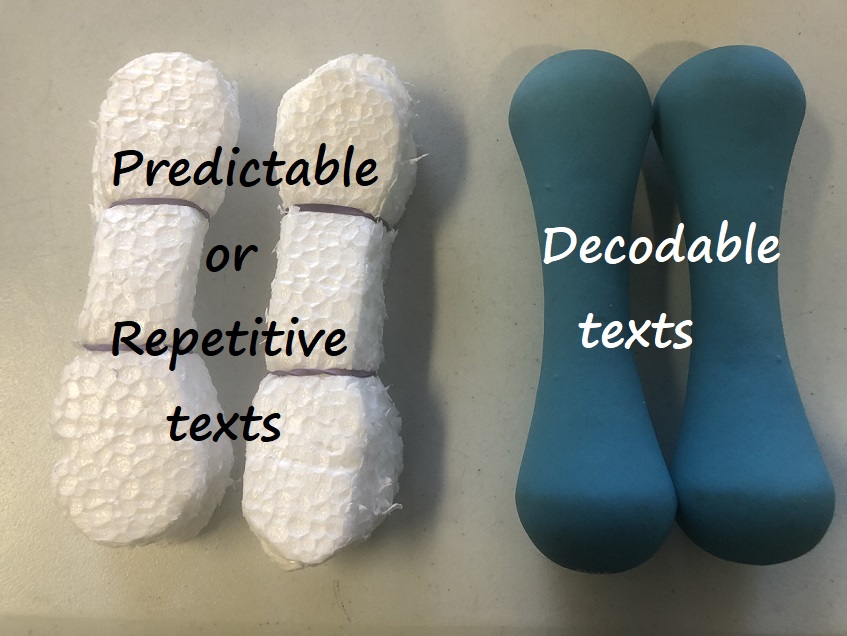
If you went to a gym and they told you their weights were made of polystyrene because lifting real weights makes people sweat and grunt and isn’t pretty to watch, you’d walk straight out.
Predictable/repetitive texts are like fake weights at the gym. They make the exercise easier and less painful to watch, but they don’t build reading muscle.
Next time you’re watching a child slowly and laboriously sounding out words in a well-selected decodable book, cheer them on. Don’t wish it wasn’t hard or try to make it easier. All that sweating and striving is because they’re building their reading brain, which is such a powerful and wonderful thing to do, and well worth the effort.
Top 10 online PA/phonics resources/activities
23 Replies200+ days in COVID-19 lockdown and no clear end in sight, so I’m scratching around for fresh ways to target phonemic awareness, phonics and morphology online. Maybe you are too. Here are some things I was SO GRATEFUL to find. A million thanks to their creators. Please add your favourite resources and ideas in the comments.
- Wordwall
I think my head would have imploded in the last 18 months without a Wordwall subscription (AUD$12 a month for all the games). I’ve made lots of activities which you can use for free, and so have many others.
Only the crossword, hangman, spell the word and anagram games require spelling rather than reading to play, but not to create. I therefore get kids to help me create a game online: first choose a game, type the target words/sentences into it, then play the game, then go on the leader board. Playing the game again can be part of the homework, either on a computer or as a printable crossword or word search. It’s also possible to make little moveable alphabet/sound swap activities in the word magnets activity.
2. Phonic Books Moon Dogs At Home books and other resources
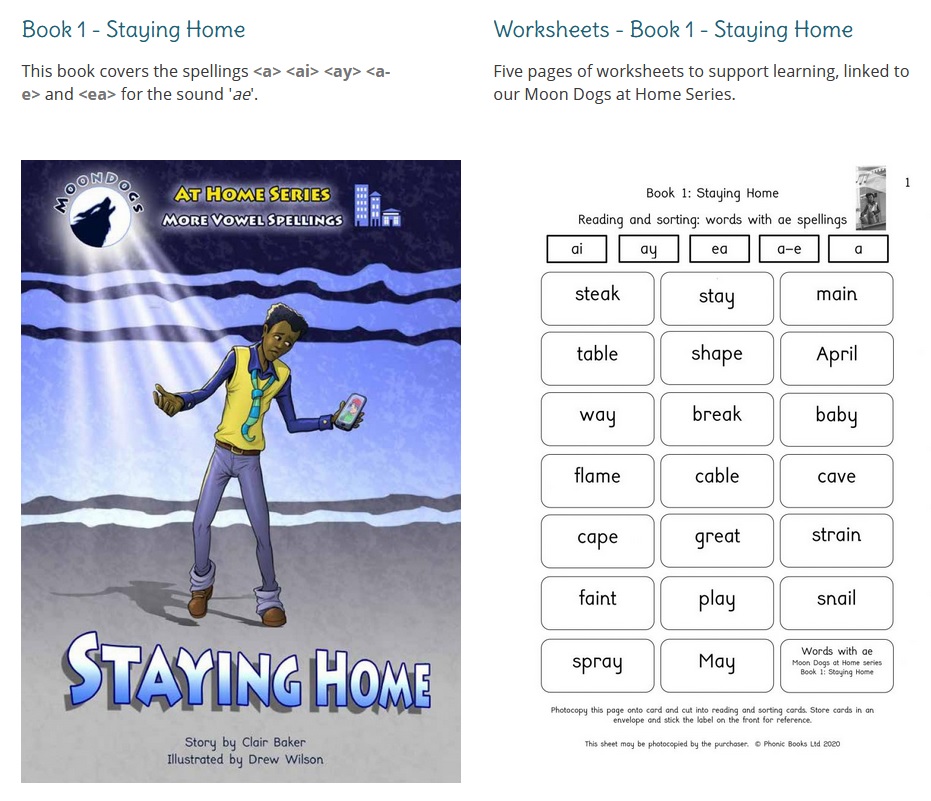
We use the physical Phonic Books resources a lot, and have found their free online resources very useful during our lockdowns. So generous, and so relevant. A lot of the WordWalls we’ve created also match their books’ teaching sequences.
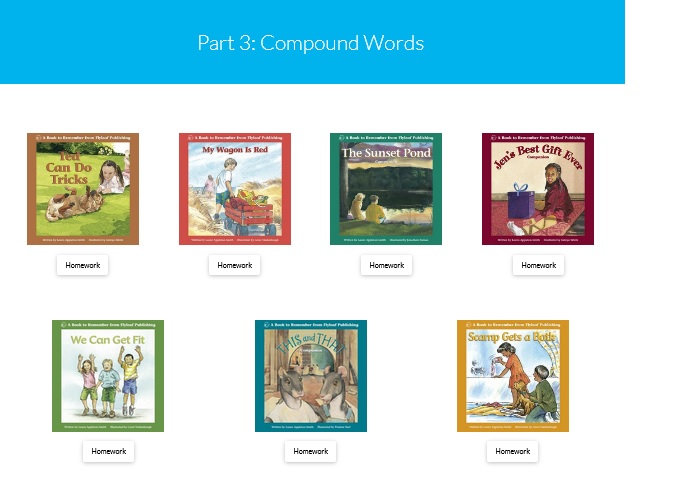
Flyleaf’s Online Portal contains lots of cute books from the UK which are perfect for online use, and all free at present, because of the pandemic. Again, so generous! Jen’s Best Gift Ever is my favourite, click here to read it, and here’s a comprehension quiz I’ve made as a follow-up activity (use it as a Gameshow Quiz for more pizazz).
4. ICT Games
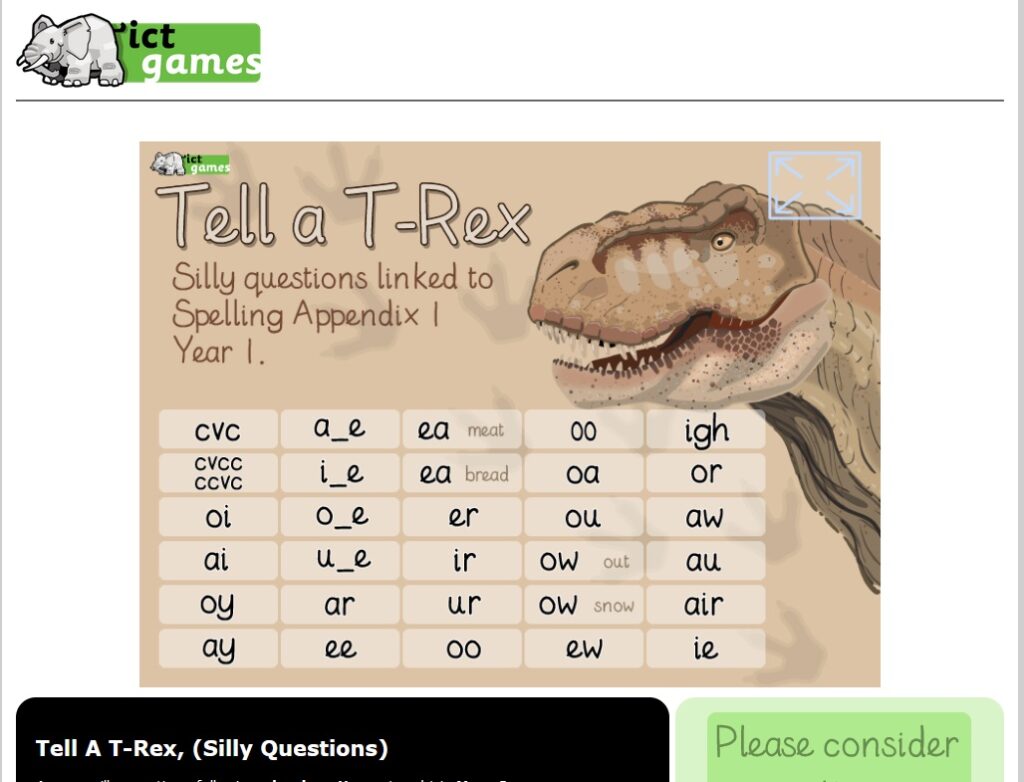
ICT games are all free online, and a quick, fun way to warm up or finish off a session. I often ask kids to type their own lists into Help A Hedgehog, then see how many they can read before the 90 second timer runs out. Other favourites are Tell A T-Rex, Poop Deck Pirates, Viking Full Circle, Forest Phonics, and Phonics Finder. This site runs on a donation model because the husband-and-wife team behind it think no child should be prevented from learning by lack of money. So if you can afford to donate, please do.
5. Sounds Write Practitioners’ Portal and freebies
All of us at Spelfabet have trained in the linguistic/synthetic phonics program Sounds-Write, so we have access to the Sounds Write practitioners’ portal, which has heaps of ready-to-use activities following their teaching sequence. There is also a facebook page where Australian and NZ Sounds-Write practitioners share ideas and resources.
Sounds-Write also have quite a few free resources which can be used online such as decodable books.
6. Little Learners Love Literacy apps and other resources
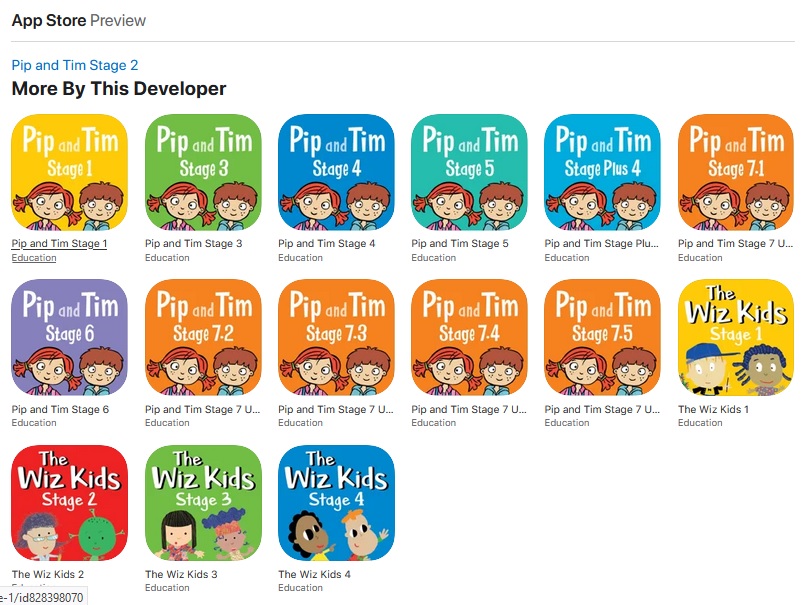
The app versions of the lovely LLLL books have been a great way to show young clients the books, by sharing the iPad screen online. These books were made available free during the COVID lockdowns. Lots of paper-based LLLL activities also lend themselves to online use, see item 8 below. If you’re working online on Zoom, you can share your iPad/iPhone screen online (either with bluetooth or plug it into your computer), but kids can only see it, not operate it (unless I am missing something). That means they can read whatever decodable texts you have on your iPhone/iPad.
Not sure whether this works on online platforms beyond Zoom, or whether you can share Android screens, sorry. The internet will probably be able to tell you, with videos, if it is possible.
7. Powerpoint versions of decodable texts
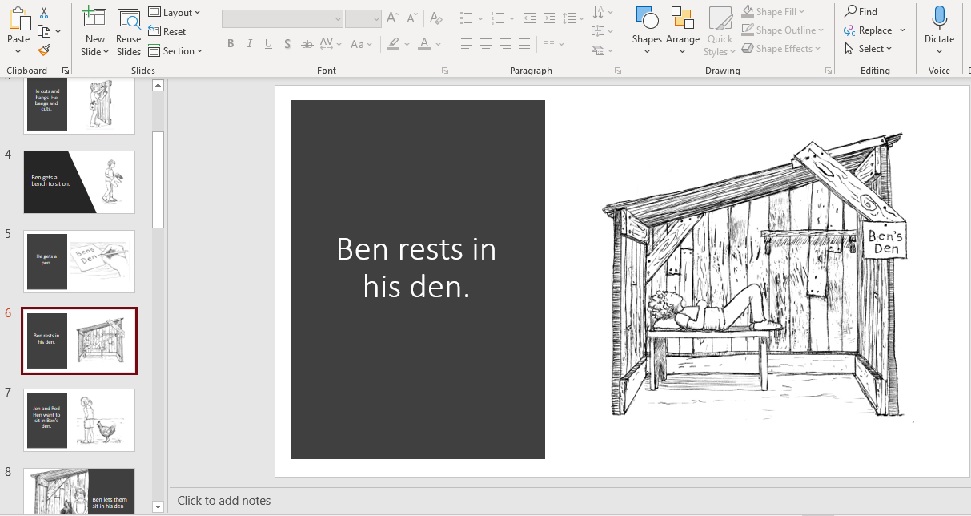
Some kids with good keyboarding skills like typing a simple story to dictation, to create a book they can then show a parent or teacher. I’ve used some Phonics With Feeling books for this, with author permission. I take screenshots of the pictures and paste them onto slides, type the text, then use Powerpoint’s formatting suggestions to make it look more schmick. Then I save it, delete the text and save it again under a different file name. Voila! A simple onscreen reading then spelling activity with large text.
8. Adobe Acrobat Reader editing tools
We use Zoom and it has been excellent, but I rarely use their whiteboard or editing tools. The free Adobe Acrobat editing tools work much better with pdfs. You can scroll through homework and cover it in ticks. You or the learner can type, change the font size and colour, and move text around. You can underline or put boxes around target words in sound searches (we play a guess-how-many-jellybeans-in-the-jar game with these, first guessing how many words with the target sound there will be). I just wish I could turn off the predictive text! (any ideas? I’ve tried everything!)
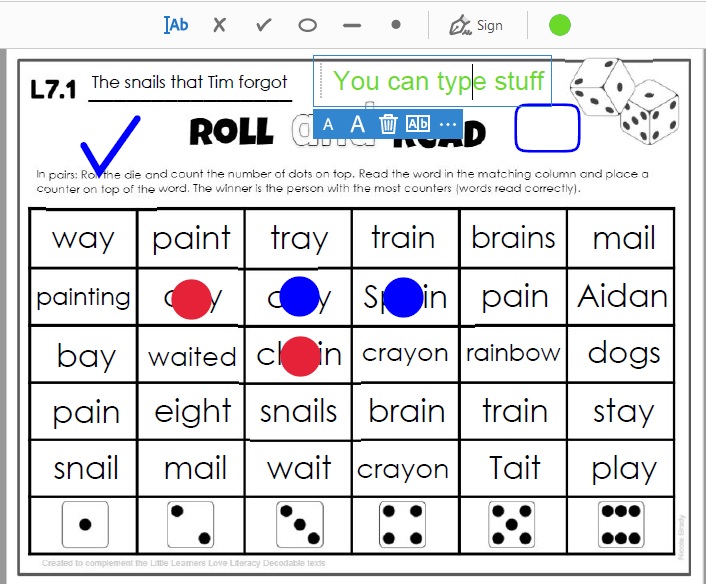
You can also play games (like the one above from Nicole Brady) using big dots as counters. Sounds-Write, Phonic Books and Little Learners Love Literacy books all have paper-based games that can be scanned as pdfs and used this way, and there are digital versions of the LLLL books. I use the iPad or iPhone app Make Dice held up to the camera for dice games, as I’m rubbish at online dice (all tips gratefully received). Make Dice can also replace the spinner for the Phonic Books Spin, Read and Spell games.
9. Kahoot!

I’m sad to say that I’ve only recently figured out that Kahoot! can motivate many kids to do quite a lot of reading. The best music teacher in the world (hi Roz!) told me it had revolutionised her lessons. Kids are often familiar with it from school, and think it’s fun and cool. We’re writing some downloadable quizzes now which should be easy to turn into Kahoot!s.
10. Jamboard is no longer available in 2025, Really Great Reading has letter tiles worth checking out, but I am still working out how their subscription works.
Google’s Jamboard was another useful tool I wish I’d discovered earlier. It was like an online whiteboard with colourful post-it notes, from which I made simplified versions of my moveable alphabet for word-building sequences, e.g. here the learner would be asked to change “stitch” into “switch”:
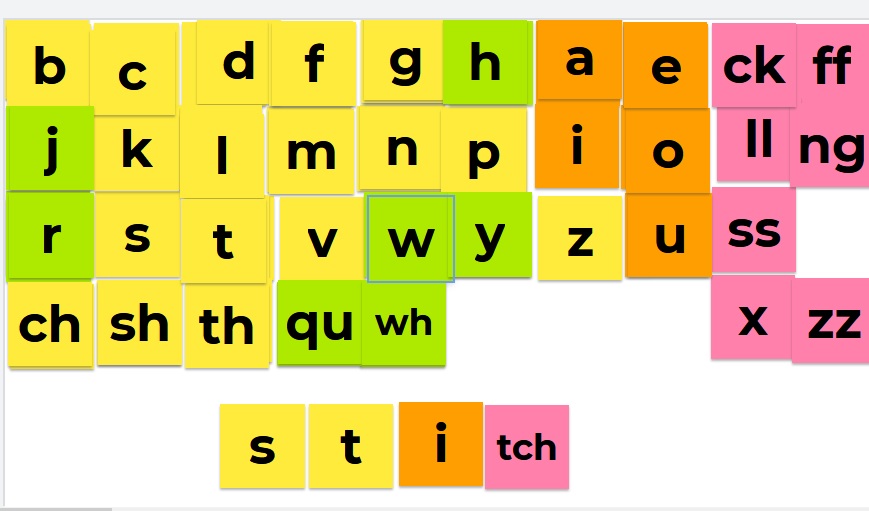
Kids tend not to stretch or rotate the tiles the way they have in other formats I’ve tried using for this activity. Jamboard was also a quick way to create neat word sorting activities:
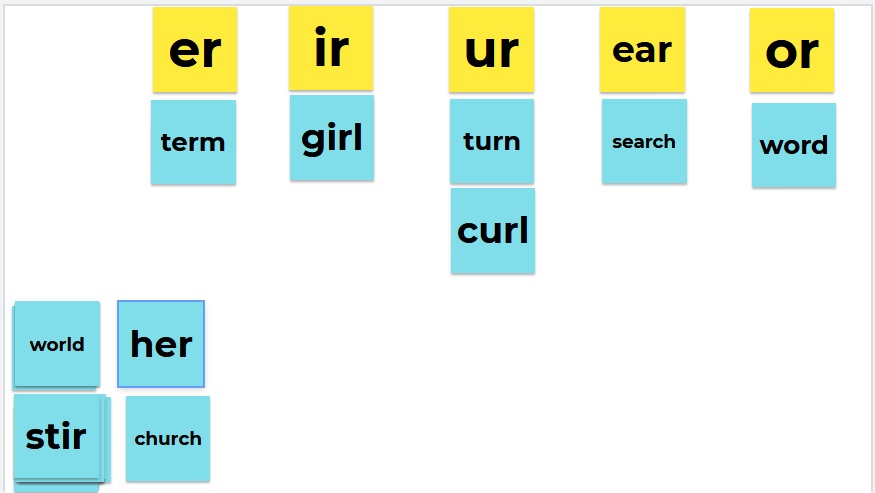
I got words for these sorts from my website’s sorted-by-sound lists (for same-sound-different-spellings activities) or sorted-by-spelling lists (for same-spelling-different sounds activities).
I hope you found some useful information in all that, especially if you’re still working online too. Pretty please leave any great ideas you have to share in the comments.
2025 extra thoughts: There are lots of free, downloadable decodable texts on the Freereading website, and the Preschool University website also has affordable digital materials including decodable texts. Great for dictation, as the learner can read the text on screen and think about anything that might be tricky in it before starting to write/type.
If the learner has a parent/support person with a phone with a camera and a different email address from the one the learner is using to sign in to the Zoom, they can also join the Zoom from their phone and use it as a document camera. This allows you to see what the learner is writing. The phone can be inserted near the top of a stack of books, cans of beans, whatever, with the lens sticking out, and then the learner’s paper/whiteboard can be placed under the lens and the camera focussed/adjusted as necessary.
Don’t waste school PA time on syllables and rhyme
63 RepliesOur education system seems to be abuzz with discussion of the importance of phonological awareness, which is excellent. Most difficulties with reading and spelling English words can be traced back to poor awareness of the sounds in words.
However, I’m worrying that valuable lesson time is being wasted teaching school-aged children awareness of large, salient phonological features like syllables and rhyme, instead of focussing on individual phonemes, the smaller, harder-to-discern sound units represented in our writing system.
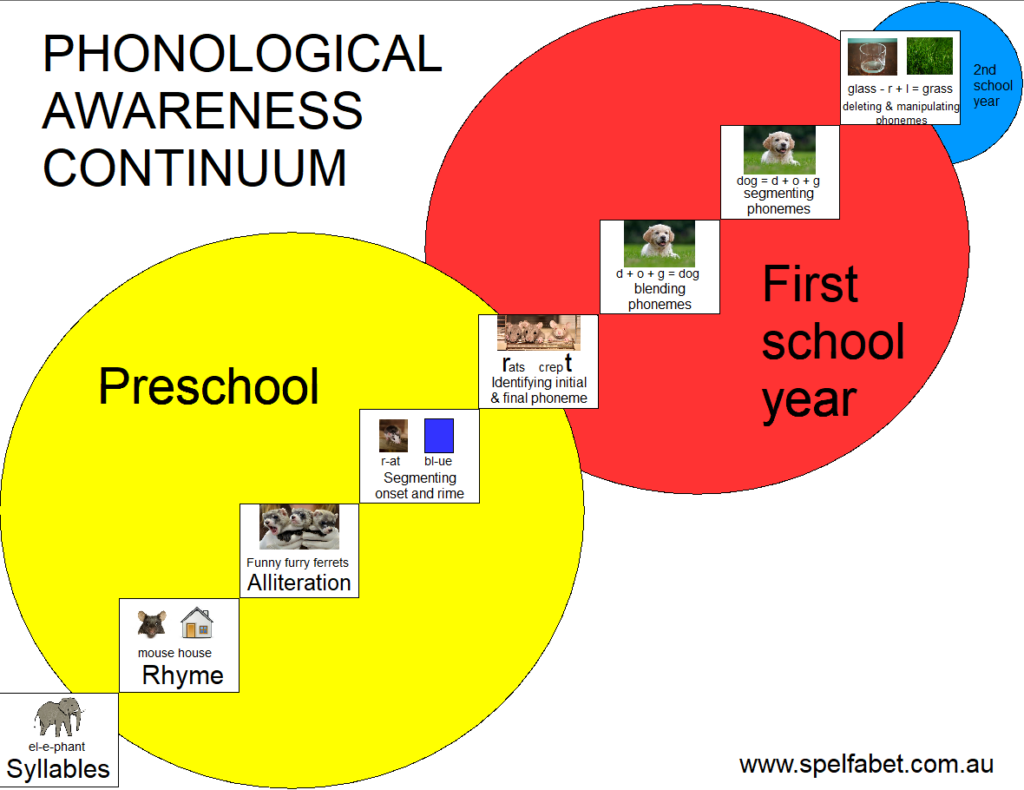
Various versions of the above phonological awareness continuum diagram, minus the circles I’ve added, have been floating around our education system for years, and probably helped foster the common misconception that awareness of syllables and rhyme are prerequisites for developing phonemic awareness. Yes, preschool rhyming skills tend to correlate pretty well with later reading skill, but correlation is not causation.
The Reading League in the US last year published a review of current research on phonemic awareness and phonics by University of Rhode Island Emeritus Prof Susan Brady, which concludes it’s not necessary to devote time and effort to fostering awareness of syllables and rhyme/onset-rime before children can acquire phonemic awareness. You can read the long version here, or a briefer version in their journal. Prof Brady uses the term “phonological sensitivity” for larger-chunks phonological awareness (everything except phonemic awareness).
Phonological sensitivity is evident across cultures, and acts as a mnemonic
Prof Brady writes that, “In cultures not having the benefits of literacy, phonological sensitivity skills have been documented, but not full awareness of phonemes, even by adulthood” (p6, and she refers to this old but interesting study, I guess there now aren’t many non-literate cultures available to study).
Ancient poems, chants and songs from predominantly oral traditions often have strong metrical structure, rhyme and/or alliteration. These are still features of poetry and song around the world, though admittedly my research on this has only been via travel, our excellent local Boite World Music events, WOMADelaide, and reading internet articles with titles like “9 Countries Whose Traditional Forms of Poetry You Didn’t Know About”.
As well as being integral to art forms, these phonological features make information easier to remember and transmit verbatim. The Iliad might have been lost to an ancient game of Biddelonian Whispers without its strict metrical structure. Beowulf might have drifted and dissolved into diverse dreadful dramas, and I doubt we’d remember the words of our favourite songs so exactly if they were written in free verse.
Phonemes are more difficult to discern, but are also powerful mnemonics
Phonemes are invisible and transient, and blur together when we speak in a process called coarticulation, making them hard to separate out. There’s no reason to be aware of phonemes unless you’re learning an alphabetic writing system.
Dr Linnea Ehri chaired the US National Reading Panel’s investigation of phonological awareness 20 years ago, and has been a leading researcher on phonemic awareness since then. I love her analogy of the phonemes in spoken words holding the “glue” needed to hold written words in memory. When children become aware of phonemes, they activate the glue. You can hear Dr Ehri talk about this from the 60 minute mark of this Reading League podcast, I’m sure you’ll then want to listen to the whole thing.
Dr Ehri explains that teaching children to say words slowly, listening for their sounds, and thinking about their mouth movements, builds phonemic awareness. It’s highly effective to use letters to represent sounds in phonemic awareness activities, as this makes the relevance/purpose of the activity clear and transferable, but representing sounds with tokens (buttons, shells, gemstones, banana chips, whatever) is also effective, for example with children who don’t yet know letters. Dr Ehri doesn’t talk about handwriting in this podcast, but I’m sure she would agree that saying words’ sounds while writing their spellings is also a powerful word-glue-activating activity.
This phonemic awareness continuum is seriously underspecified
If you look at the phonemic awareness steps in a typical phonological awareness continuum diagram, they’re not very informative. For a start, there aren’t many of them for such a complex and difficult process. Blending usually appears before segmenting, though these are reciprocal processes, and should be taught and learnt as such.
There’s also no useful detail on word types, though it’s obviously easier to blend and segment a word with three sounds, like ‘cat’, than it is to blend and segment a word with seven sounds, like ‘scripts’. It’s easier to delete or manipulate a single initial phoneme, like the ‘c’ in ‘cat’, than it is to delete or manipulate the ‘c’ in ‘scripts’. I’d also expect the average six-year-old to find it harder to blend/segment the word ‘scripts’ than to delete/manipulate the first sound in ‘cat’, so deletion/substitution aren’t always the hardest phonemic awareness activities. It all depends on phoneme identity, order and number.
If we represent vowels with V and consonants with C, then list all the possible combinations of these in single syllable words in English, putting example words in brackets, the list goes something like this: V (eye/I), VC (up), CV (go), CVC (hot), VCC (elf), CCV (stay), CVCC (help), CCVC (stop), CCVCC (crust), VCCC (ends), CCCV (spree), CVCCC (tents), CCCVC (strayed), CCVCCC (frosts), CCCVCC (splint), CCCVCCC (sprints) and CVCCCC (texts). These should be represented on the phonemic awareness continuum.
In general, it’s easiest to discern the first sound in a word, then the last sound, and then sounds that are in the middle. Internal consonants are especially hard to discern, which is why young children often write ‘stop’ without the ‘t’ and ‘help’ without the ‘l’. They blur into the sounds around them and get a bit lost. Sound type can also make a difference, for example the sounds /r/ and /l/ have vowel-like qualities, so sometimes children consider them part of the vowel.
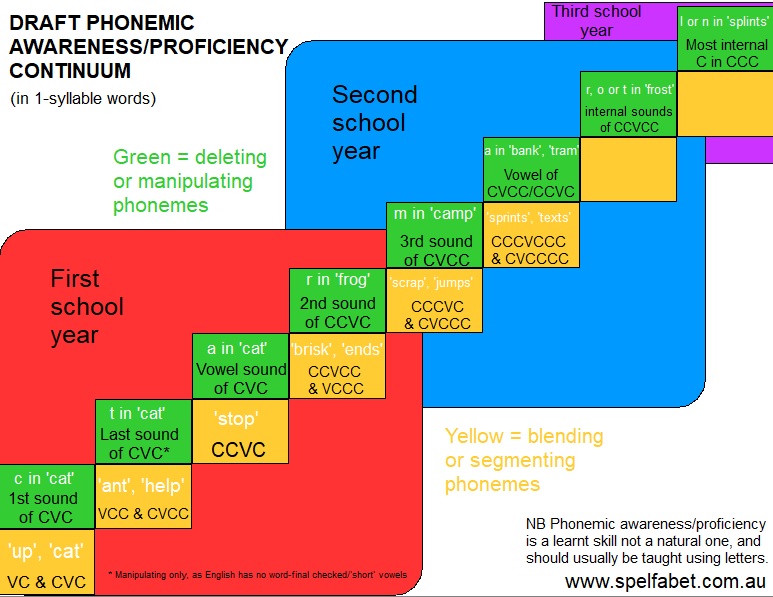
I’d like to propose the above as an interim replacement for the less-helpful phonological awareness continuum diagrams currently floating around our education system. I’m sure people smarter than me (perhaps you?) can and will improve on it.
Nothing against syllables and rhyme for preschoolers, in fact I am planning to enjoy lots of them with my three preschool neighbours when our COVID Lockdown 6.0 finally lifts. But school-aged children need to activate their remembering-written-words glue by focussing on phonemes.
